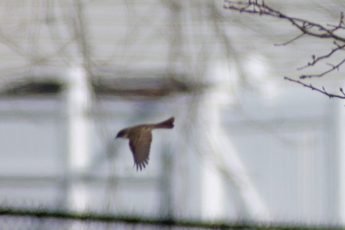“Do they have owls?” was the first question I asked Mike Freiberg. Mike had just invited me to Nikon’s Prostaffer Retreat that was to be held at a ranch in south Texas. He wasn’t sure of the answer to my question so he referred me to the manager of the ranch. I immediately phoned the manager and enquired if the property had any Ferruginous Pygmy-Owls. Maybe it was my weird accent or maybe the ranch manager had wax in his ears – but I didn’t get the response I was looking for. “Indigenous pig sows?…Sure, we got lots of ’em javelina and wild hogs too”. But I explained to him that I was a hunter of a different kind and that I was looking for tiny owls and not wild pigs. I went on to tell him that I’d seen these birds in Central America but that I needed to see them in the US too. This comment spurred the manager into realizing that I was a freak and part of the birding crew he was expecting. He told me that he had never seen the little owls that I was referring to. But owls or no owls, I was going to the retreat anyway – a great opportunity to relax, do some birding and hang with friends.
 Birding at sunset in Willacy County, south Texas
Birding at sunset in Willacy County, south Texas
In years gone by, the chosen site for the retreat was part of the southern extremity of the King Ranch, a property of legendary status amongst US birders, most notably for its population of Ferruginous Pygmy-Owls. Situated in Willacy County, the place is diverse, with large patches of wetland, open grassland and mesquite thickets. However, after arriving at the ranch we were a little dismayed to learn that there was no oak habitat on the ranch, the preferred habitat of the owls on the nearby King Ranch. But nevertheless, this part of the country is home to an astonishing variety of birds and a good number of species that are found nowhere else in the US. The birding was superb with Aplomado Falcons, White-tailed Hawks, a single Zone-tailed Hawk, Peregrine Falcons, migrating Cooper’s and Sharp-shinned Hawks, Harris’s Hawks, White-tailed Kites and good numbers of Crested Caracaras.
 An Aplomado Falcon by Tom Dunkerton
An Aplomado Falcon by Tom Dunkerton
 A soaring White-tailed Hawk by Tom Dunkerton
A soaring White-tailed Hawk by Tom Dunkerton
 A nice group of Harris’s Hawks by Bill Schmoker
A nice group of Harris’s Hawks by Bill Schmoker
Not only is this area well-known for limited distribution birds but also sheer numbers. The waterbird concentrations can be stupendous at times and flocks of hundreds of Roseatte Spoonbill, White Pelicans and Long-billed Curlew respectively are not uncommon.
Raccoons join waterbirds in the wetlands of Willacy County Bill Schmoker
The birding was so good that I had all but forgotten about Ferruginous Pygmy-Owls. These wily and diminutive owls occur from Bolivia and Argentina northward through Central America (check out this post on Pico Bonito) and only just occur in the United States in Arizona and south Texas. Its interesting to note that, although the bird just crosses the US border, two distinct races can be found. The Arizona birds are from the cactorum race and these birds are often referred to as the Cactus Ferruginous Pygmy Owl. In fact, this sub-species was formerly classified as endangered in the US under the Endangered Species Act. There is some debate (and recent genetic evidence) that the northern birds (both the Texas and Arizona birds) may comprise an entirely distinct species, Ridgway’s Pygmy-Owl but this is not widely supported by the majority of check-lists.
I was sitting at the lodge pool watching a steady stream of White Pelicans and raptors kettling and soaring overhead when I saw Bill Schmoker running and shouting. He was gesturing like a madman. Out of breath he finally arrived at the pool and told me that they had located a pair of owls right at the entrance to the lodge itself in a mesquite thicket. “Schmoking Ponies!” I ran and got my scope and video stuff, tripped in a pothole, twisted my ankle and somehow limped to where the group were huddled. Sure enough, there they were. A pair of Ferruginous Pygmy Owls! Moez Ali, one of the Nikon Prostaffers, had heard the distinctive call of the birds and had located them with ease. Right at the lodge. In habitat that we least expected.
 A Ferruginous Pygmy Owl peers back at the camera Tom Dunkerton
A Ferruginous Pygmy Owl peers back at the camera Tom Dunkerton
I’ve gotta say that I’m a massive fan of the Glaucidium genus of owls. Growing up in South Africa, I fell in love with our two representatives of this genus, the Pearl-spotted Owlet and the Barred Owlet. With their piercing eyes, aggressive nature and tiny size these birds evoke images of featherweight boxers – small but packing a serious punch! The same can be said for the pygmy-owls of the Americas and in fact, just like their African counterparts, the Ferruginous Pygmy Owls have a pair of unique false eyes at the back of their heads as a possible deterrent to would-be predators (click on the video to see this adaptation). Unlike the Elf Owl, which feeds mostly on insects, the Ferruginous Pygmy Owl has disproportionately large feet and talons. And, like the Pearl-spotted Owlet of Africa, this species often hunts in the middle of the day.
 A nice Ferruginous Pygmy Owl showing its rufous tail. Note the large feet. Bill Schmoker
A nice Ferruginous Pygmy Owl showing its rufous tail. Note the large feet. Bill Schmoker
Over the next couple of days we located another pair of owls so it seems as if they may be more common in the area than previously believed. After all, this species is a widespread and common bird in Central and South America. Whilst filming the birds for well over an hour I was amazed at just how confiding they are. Fearless little predators. Although on several occasions I witnessed the owls carefully track other raptors that flew over – White-tailed Hawks, Harris’s Hawks and even Turkey Vultures.
 An owl peers at a White-tailed Hawk flying overhead James Currie
An owl peers at a White-tailed Hawk flying overhead James Currie
Mission accomplished! Its amazing how many times I’ve been surprised by birding. Finding a bird when I least expect it. This was one of those special times. Even if it meant sustaining a sprained ankle in the process!






 New writers welcome – please contact us for details.
New writers welcome – please contact us for details.

















Beautiful owl photos, and a good story, too, thanks!
Must get to Texas…must bird Texas…why is every birder in Texas but me… Oh, yes, James, great video, fun story. Enjoy Texas!
Thank you so much for these wonderful, unique shots of wildlife around you there! Not sure how I lucked into getting this on my FB but so happy to have found you! Keep up the news and education…on birds, etc. especially for those of us who want to learn and can’t get out into the woods enough! yo! Thank you thank you
“Indigenous pig sows”…Im going to have to remember that one. Glad you got to run/limp into these birds!
Loved this article, particularly the video clip. I was surprised how active the little guys were in the daylight.
Hello, I was looking at your great photos of the Ferruginous Pygmy Owls.
I am the owner of San Miguelito Ranch where the FPO’s are common in my front yard in the spring.
Please look at our website.
You might just want to visit us one day…
Truly,Leticia